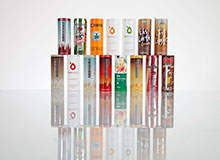

Eco-Friendly Cartocan Packaging
The unique Cartocan from Ennstal Milch offers a shelf-life of up to 12 months unchilled without affecting aroma, colour and taste. Its major selling point, however, is that it has the lowest carbon footprint when compared with aluminium and PET cans.
Cartocan is the packaging of choice for premium drinks brands such as Purelosophy’s 100% natural drinks and Naturaplan’s bio Botanic Energy drink. Its sustainable materials, carbon footprint control and robustness mean that it is hitting the zeitgeist for the current packaging trend for sustainability. Offering a white, natural clean look as well as the standard aluminium can imitation, the Cartocan is gaining momentum in the premium, packaging market.
Frances Marcellin: Why does the drinks industry need a packaging product like the Cartocan?
Ewald Gallob: Cartocan is unique as it is at least 30% more eco-friendly than Alu and PET. 60% of the packaging systems consists of sustainable forests and the haptic of the can is very special and pleasant. Differentiation nowadays is the key word and especially in the beverage industry you need added values, not just through the recipe and the positioning itself, also by means of individual packaging.
FM: How did the idea for the concept of the Cartocan come about and how is it made?
EG: The idea was generated in 1997, benchmarked from the alu can, but to be much more eco-friendly and achieve a lower carbon footprint. The robustly hydrophobic cardboard consists of eight different layers. This ensures 100% safety for the product content and avoids influences in aroma, colour and taste. It is delivered flat (wounded in roles), formed, filled and sealed at the line in Stainach, Austria.
FM: How long did it take to develop the Cartocan and how long has it been around?
EG: Ennstal Milch built up an ultraclean line in 1998. Because of the success of the packaging system, Ennstal Milch invested in a full aseptic filling line in 2012. This new machine ensures more flexibility in terms of packaging sizes – the new filling line can also do a mini version, so 130-150ml – and the main advantage is the ambient storage of one year, also for milk products and other pH-neutral products.
FM: How is the Cartocan being received by the industry so far?
EG: Landessa Egg Nog and the Hibiscus drinks are the newest products filled at our line. We haven’t had a long sales period but we believe that it will work. Nevertheless, the key for success is not just the Cartocan, it must be a complete concept of marketing. But we are sure that the influence of the packaging system is very positive. For example, one retail partner in Austria tested the cardboard can against the alu can – and we won the race. The consumer arrogates environmental concepts.
A very successful customer and partner is Shatler’s in Germany. The company offers 14 different ready-to-drink cocktails (non-alcoholic and alcoholic) and provides a convenient alternative for bars, restaurants and events. For two months we have been producing different coffees under the brand Galaxy Café for Mars Drinks in UK. The range of our customers is very big; it starts with milk-based products, water-based wellness drinks, and smoothies, and ends with cannabis ice tea.
FM: How is the packaging able to offer a shelf-life of up to 12 months unchilled?
EG: The product is heated, the packaging sterilized with hydrogen peroxide and this avoids any bacteriological influence.
FM: What printing options are available to brands?
EG: Using the Flexo-process, we print on two different basic materials: white background – this effect is suitable for wellness and bio-based products – and alu-imitation – this effect makes the product shine even more and is particularly suited to products with a high range of additional benefits.
FM: Why is the Cartocan better for the environment than traditional cans?
EG: A comparison of the Product Carbon Footprint of packaging for non-carbonated drinks made of Cartocan, aluminium & PET demonstrated significant benefits for Cartocan. The Carbon Footprint provides information on the total CO2 emissions generated by a product. Denkstatt analysed the Carbon Footprint involved in the production and waste management of these three different types of packaging and Cartocan is shown to have the smallest Carbon Footprint. The main benefits of CartoCan as compared with aluminium is in the area of raw materials. The use of 50% renewable raw materials in CartoCan generate significantly fewer greenhouse gas emissions than in the energy intensive production of primary aluminium.
FM: Where do the materials to make Cartocan come from?
EG: As proof that all wood fibres used in the production process are taken from forests managed in an exemplary fashion, Cartocan packages have the right to bear the Forest Stewardship Council (FSC) label. The FSC label is recognised throughout the world as one of the most prestigious awards for the processing of wood fibres, which demonstrably originate in forests that have been certified in accordance with the FSC guidelines.



